Vaccinazione umana, vaccinazione animale e retrovaccinazione antivaiolosa nel Regno di Napoli (XIX secolo)
DOI:
https://doi.org/10.13135/2724-4954/11075Keywords:
Cowpox Vaccination, Animal Vaccination, Retrovaccination, Vaccine SyphilisAbstract
At the beginning of the nineteenth century, in the Kingdom of Naples, the smallpox vaccination campaign was started, following the similar campaign carried out for the English Navy. The same method of active immunization was used, namely with the vaccine coming from the strain bovine viral, active as an immunizing agent, but not pathogenic for humans, with direct inoculation between one individual and another. The large-scale implementation of “arm-to-arm” vaccination involved difficulties related to both the procurement of the immunizing agent and the methods of inoculation of the vaccine itself. Furthermore, popular hesitancy combined with that of some institutions, made the campaign really effective only after a very long time. The worst, and sometimes fatal, consequence was represented by the transmission, through this system, of syphilis and other diseases. In this context, some physicians appointed by the Royal Administration, including Galbiati and Troja, developed an ingenious vaccination “protocol” in Naples through a substantial modification consisting of the conservation of “vaccine pus”, which used the bovine breed as an intermediate host and reservoir of vaccine material; this modification allowed for the possibility of expanding the production of the vaccine and drastically improving the conservation of the effectiveness of the vaccine, which was decreased due to the transfer between humans as well as to the difficulty of transporting it. Furthermore, by not resorting to the human species as a “reservoir” for vaccine material but by using cattle as an intermediate host, which could not transmit syphilis, the consequent spread of infectious diseases, often even lethal, was avoided.



